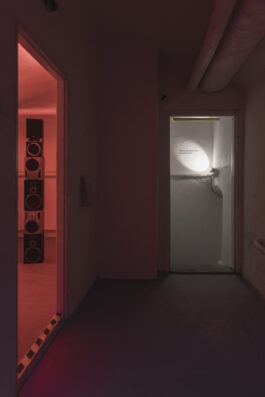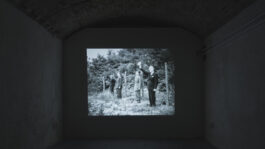
From Sea To Sea
Information
Galéria HIT, Bratislava, Slovakia
03.10. — 14.11.2029
Curated by Lýdia Pribišová
In his practice, Nikolay Karabinovych questions the categories of place and time. He examines the fluid identities of post-socialist Eastern Europe, new nationalisms and contradictions of historical narratives. A significant part of his practice comprises working with sound. He has been developing a music archive, understood as an important anthropological source. He often collaborates with musicians and theatre.
Through analytical, conceptual or interventionist tactics, he usually departs from the historical research and approach to collective and personal memory. Two of his projects presented in Hit Gallery are based on the tragic history of the artist’s family, testimonies as to how the individual history is intertwined with the global one.
Both these stories are about oppression of the minorities and brutal intervention of the hegemonic forces.
The title of the show, From Sea to Sea, refers to the old time hegemonic ideas, which are present in popular Balkan songs in Serbia, Turkey and Bulgaria and other counties as a residuum of dreams of a big national empire.
The voice of thin silence (2018) is a work based on the lifestory of the artist’s great grandfather. He was of Greek origin and in 1949 he was repressed and deported from Odessa to Kazakhstan. The artist’s father had never met him but heard a lot about him from his mother. His father always wanted to go to Kazakhstan to see the place where he died but never managed to make it. Nikolay was always fascinated by the Greek traditional rebetiko music, which remind him of his great grandfather.
Nikolay invited the composer Yuriy Gurzhy of Greek roots to create lyrics and music for the song based on rebetiko and dedicated to the repressed Greeks. Few weeks after the song was recorded, he went to the small Kazakhstan village of Chilik, where his great grandfather died and installed a loudspeaker playing this song in its surroundings.
Another work, the video titled Romania, Romania (2019) is inspired by the life of the artist’s great-grandmother from his mother’s side, born into a large Jewish family in the village of Bryanka, the Lugansk region of Ukraine. She used to live in Odessa. In 1941, when the Romanian troops entered the city, she was first hiding in the catacombs and small caves near Odessa, later deciding to return to the city. Before going back, she burned all the Jewish documents and changed her name to a Russian version. However, she guessed that the copies were stored in the local archive. When she returned home, she discovered that the Romanian commandant of Transnistria had settled in their house. In a few days, she turned completely gray. Her daughter, the artist’s grandmother, managed to escape as a child, despite the scorching everyday fear. The video at the exhibition shows the execution of this commandant, Marshal Antonescu and other commanders, accompanied by an old Klezmer song, Romania Romania sang by the artist.
The third work presented on the show Play it Loud (2019), is touching on another topic, the growing nationalism. It is a sound sculpture, composed by old loudspeakers from which a mixture of various (Serbian and Bosnian) turbo folk songs can be heard, fighting among themselves, creating a confusing cacophonia.














Press

